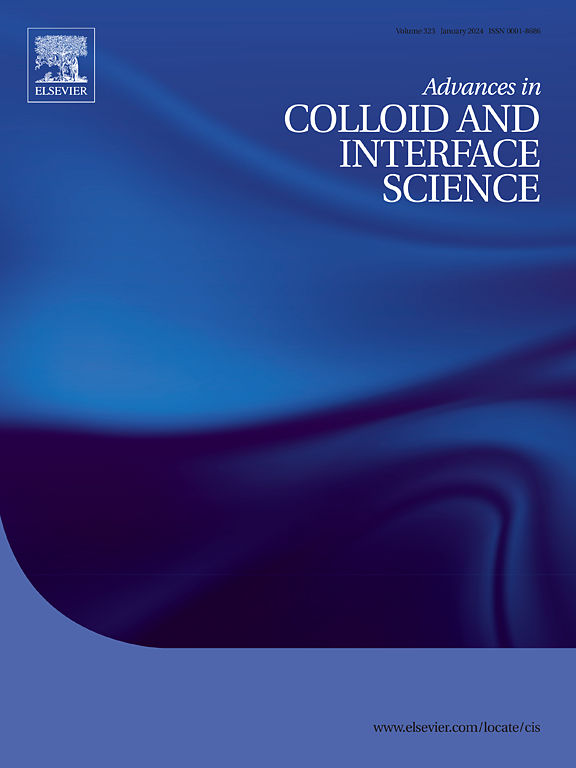大振幅振荡膨胀表面流变学研究进展
IF 19.3
1区 化学
Q1 CHEMISTRY, PHYSICAL
引用次数: 0
摘要
大振幅振荡膨胀(LAOD)表面流变学是表征泡沫和乳液等多相系统中气液和液液界面非线性力学行为的新兴工具。这些界面由表面活性剂或乳化剂稳定,表现出复杂的粘弹性,在大变形条件下显著影响气泡和液滴的稳定性。传统方法主要关注线性粘弹性行为,而LAOD使我们能够探索界面的非线性变形行为,从而更深入地了解界面在大变形时的力学性能。本文综述了界面膜膨胀流变学的主要进展,提供了LAOD实验设计、数据收集和分析技术的综合背景。数据分析的最新发展已经彻底改变了lad技术。在过去,Lissajous图给出了定性的见解,而新的一般应力分解(GSD)方法允许对非线性进行更多的定量分析。GSD可以定量地分离应力响应中的密度驱动和实际流变(即网络)贡献。这种分离揭示了以前隐藏的流变反应,允许更准确地量化界面力学和更深入地了解界面稳定现象的机理。我们将讨论这些LAOD方法如何显著增强我们对表面活性剂、蛋白质、颗粒和混合系统稳定界面的理解。主要信息:先进lad方法的出现重新定义了我们描述非线性界面力学的方式。未来的研究应侧重于扩大GSD的应用,并重新审视以前研究过的GSD界面,这将量化以前定性描述的界面膜的行为。本文章由计算机程序翻译,如有差异,请以英文原文为准。

Advances in large amplitude oscillatory dilatational surface rheology – A review
Large amplitude oscillatory dilatational (LAOD) surface rheology is an emerging tool for characterising the nonlinear mechanical behaviour of air-liquid and liquid-liquid interfaces in multiphase systems, such as in foams and emulsions. These interfaces, stabilised by surfactants or emulsifiers, exhibit complex viscoelastic properties that significantly influence bubble and droplet stability under large deformation conditions. While conventional methods mainly focus on linear viscoelastic behaviour, LAOD allows us to explore the nonlinear deformation behaviour of interfaces, offering deeper insights into the mechanical properties of interfaces upon large deformation.
This review highlights key advances in the dilatational rheology of interfacial films, providing a comprehensive background on LAOD experimental design, data collection, and analysis techniques. Recent developments in data analysis have revolutionised the LAOD technique. While Lissajous plots gave qualitative insights in the past, the new general stress decomposition (GSD) method allows for more quantitative analysis of the nonlinearities. GSD can quantitatively separate density-driven and actual rheological (i.e. network) contributions in the stress response. This separation reveals previously hidden rheological responses, allowing more accurate quantification of interfacial mechanics and deeper mechanistic insights into interfacial stabilisation phenomena. We will discuss how these LAOD methodologies have significantly enhanced our understanding of interfaces stabilised by surfactants, proteins, particles, and mixed systems.
The main take-home-message: The emergence of advanced LAOD methodologies has redefined how we characterise nonlinear interfacial mechanics. Future research should focus on expanding GSD applications and revisiting previously studied interfaces with GSD, which will quantify the previously qualitatively described behaviour of interfacial films.
求助全文
通过发布文献求助,成功后即可免费获取论文全文。
去求助
来源期刊
CiteScore
28.50
自引率
2.60%
发文量
175
审稿时长
31 days
期刊介绍:
"Advances in Colloid and Interface Science" is an international journal that focuses on experimental and theoretical developments in interfacial and colloidal phenomena. The journal covers a wide range of disciplines including biology, chemistry, physics, and technology.
The journal accepts review articles on any topic within the scope of colloid and interface science. These articles should provide an in-depth analysis of the subject matter, offering a critical review of the current state of the field. The author's informed opinion on the topic should also be included. The manuscript should compare and contrast ideas found in the reviewed literature and address the limitations of these ideas.
Typically, the articles published in this journal are written by recognized experts in the field.

 求助内容:
求助内容: 应助结果提醒方式:
应助结果提醒方式:


